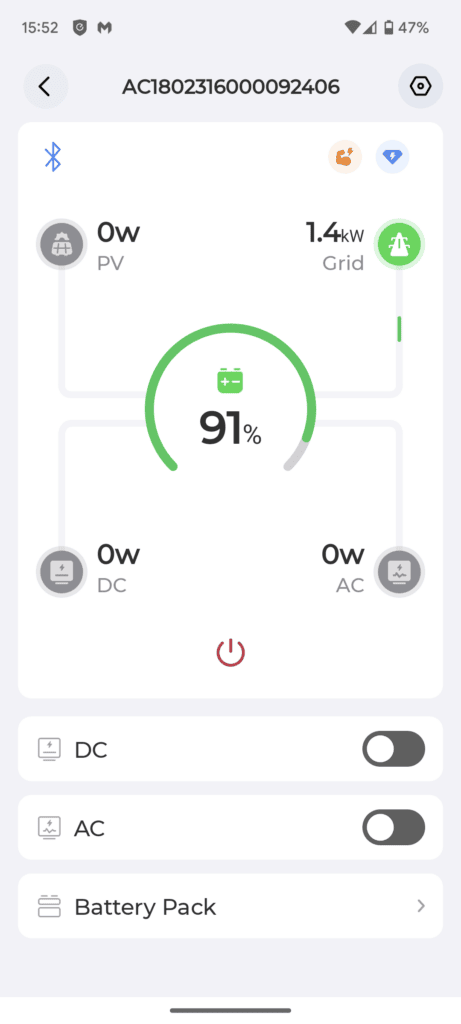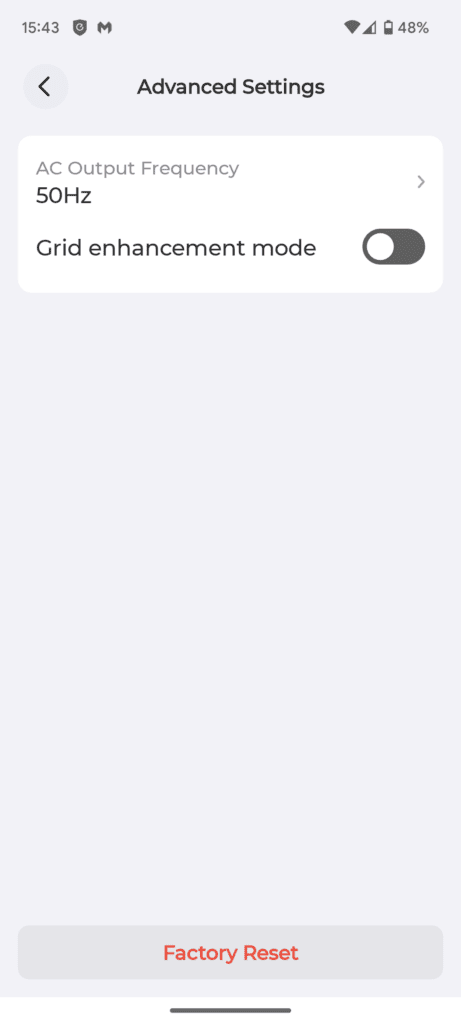Any links to online stores should be assumed to be affiliates. The company or PR agency provides all or most review samples. They have no control over my content, and I provide my honest opinion.
The AC180 is the latest portable power station from Bluetti, slotting nicely into their product lineup between the 716Wh EB70 and the 2,000Wh AC200P.
Like all the current Bluetti power stations, this uses the superior lithium iron phosphate batteries (LiFePO₄), which can do 3500 charges before the battery capacity is reduced to 80% of the original capacity vs around 1000 charges with the older NMC battery chemistry.
I’d regard this as an important product for Bluetti as it gives them a power station that directly competes with popular options from Anker, EcoFlow and Jackery, and I think it is a superb alternative option that is well worth considering.
| Preview | Product | Rating | Price | |
|---|---|---|---|---|

| BLUETTI Portable Power Station AC180, 1152Wh LiFePO4 Battery... | £499.00 | Buy on Amazon |
Specification

- Capacity: 1152Wh (36Ah)
- Type: LiFePO₄ (Lithium Iron Phosphate)
- Life Cycles: 3,500+ Cycles to 80% of Original Capacity
- Shelf-life: Recharge to 80% Every 3-6 Months
- Management System: MPPT Controller, BMS, etc.
- AC Outlet: 2 × 230V/7.8A, 1800W in Total
- Inverter Type: Pure Sine Wave
- Surge Power: 2,700W
- USB-A1: 5VDC/3A 15W in total (2*USB Ports)
- USB-A2: 5VDC/3A 15W in total (2*USB Ports)
- 12V DC Outlet: 1 × 12V/10A (Car outlet, regulated.)
- Wireless Charging Pad: 1 × 15W Max
- AC Input: 1,440W Max.
- Solar Input: 500W Max., VOC 12-60VDC, 10A
- Car Input: 12/24V from Cigarette Lighter Port
- Max Input: 1,440W
- AC Charging Cable: 1.3-1.8 Hours (1,440W Turbo Charging)
- Solar Panel (s) : 2.8-3.3 Hours (500W Max.)
- Pass-through Charging: Yes & works as UPS
- Weight: About 35.27 lbs / 16kg
- Dimensions (LxWxD): 340mm × 247mm × 317mm
- Operating Temperature: -4℉-104℉ / -20℃-40℃
- Storage Temperature: 32℉-104℉ / 0℃-40℃
- Certifications: UL, CEC, DOE, FCC, CA Prop 65
- Warranty: 5 years
- Accessories:
- AC Charging Cable
- Car Charging Cable
- Solar Charging Cable
Design & Ports vs EcoFlow Delta 2

The EcoFlow Delta 2 is the closest power station I have for comparison, so I thought it would be good to show comparison photos, giving you an idea of the size of this power station in comparison to others.
I like having all the outlets and display on the front of the unit, it helps keep things simple. The display is good and gives you all the information you need about what is going on and what features are enabled.
The Bluetti AC180 outlet selection isn’t quite as good as the Delta 2 or some other brands.
It only has two AC sockets, which is half of what you get with the Delta 2, but competing options from Anker and Jackery both have two sockets.


Then you only get one 100W USB-C and four USB-A. The Delta 2 has two USB-C ports, and the Anker PowerHouse 555 has 1x100W and 2x60W.
While it would be nice to have more AC outlets and USB-C ports, it is not a hard problem to fix, just bring an extension cable with you and a USB-C plug.
Similar to the Delta 2, this has two carry handles built into the sides, though, with this power station, they sit flush with the side, whereas the Delta 2 handles jut out.

One interesting aspect of the AC180 is that it is supposed to be IP65 rated. This technically means that the power station should be totally dust tight and can handle low-pressure jets (6.3 mm) of directed water from any angle. Bluetti sounds less confident under their FAQs and say it can resist water splashes and dust.
I have not tested the IP rating, and considering that it has fans for cooling, I am not sure I’d trust the dustproof rating that much, but it should hopefully be more resistant to the elements than many competing power stations.
This weighs 16kg which is heavier than average, albeit the battery size is a bit bigger than competing options (12.5% more capacity). The Delta 2 weighs 12kg, the Jackery Explorer 1000 Pro is 11.5kg, the Anker 555 PowerHouse is 13.5kg, and the Allpowers S1500 is 12kg.
Battery Expansion

Bluetti seems to be confused about which expansion batteries work on this power station. If you look at the main marketing page, it states:
Get your AC180 charged via expansion batteries – B80 (806Wh), B230 (2048Wh), and B300 (3072Wh) – to ensure a continuous power source of up to 4,224Wh, which is sufficient to last your outdoor fun even longer.
However, if you look at the FAQs, it states:
The AC180 only supports capacity expansion with B80 expansion batteries (in Power Bank mode) via the Aviation to DC7909 cable.
The B80 will add an additional 806Wh. However, Reddit suggests this won’t be as efficient as the implementation of the AC60 and B80.
The B80 expansion battery has an RRP of £699, though, at the time of writing, it was discounted to £599.
The B80 can also work independently, but it has limited outputs of
- USB-C Port: 1 ×100W Max.
- USB-A Port: 1 ×18W
- 12V DC Outlet: 1 ×12V/10A (Car outlet, regulated.)
When expanding the AC180, you will also need the Aviation to DC7909 cable, and this works in what Bluetti call power bank mode.
Bluetti App






You can control and change some of the settings of the power station with the Bluetti app. This connects via Bluetooth, and there is no option for WiFi on this model, but some of the more expensive models have it.
The app is functional, but it isn’t quite as good as the Ecoflow app, and there are fewer settings to customise, but it works perfectly well. I generally prefer to toggle the AC/DC on and off using the app.
The two main settings that I changed were the charging mode (I had it on silent when in the office) and switching on the powerlifting mode, which will allow the power station to drive some appliances that are rated up to 2700W.
You also carry out firmware updates via the app, and during my review period, I had updates available for the DSP and BMS.
AC Charging
This is rated for up to 1,440W input via AC charging, one of the fastest charging power stations I have reviewed. Only the 2048Wh EcoFlow Delta 2 Max charges faster at up to 2300W and costs double the price.
To enable the 1,440W charge, you need to go into the app and change the charging mode to turbo. With this mode, you should get a full charge in 1.3-1.8 hrs.
When using the charging mode in silent, the power station takes a charge at just under 300W, Bluetti say it should be 260W, the fans do spin up in this mode, but they are very quiet.
For the standard charging, the input power should be around 1000W and will give a full charge in 1.7-2.2 hrs.
Solar Charging
For solar charging, this can take up to a 500W max input, but unlike other brands, this uses a DC port for the solar input, whereas other brands use the XT60/XT90 connector. Bluetti include an MC4 to DC7909 in the box, so you should have any issue getting third-party solar panels to work with it.
The summer seems to be over in the north of the UK at the moment, but on a partially sunny day, I was able to get over 100W flowing into the power station using the EcoFlow 220W bifacial solar panel.
Performance / In Use
The AC180 is equipped with quality LiFePO₄ battery cells to ensure a longer life span – 3500+ life cycles and higher security during operation. This is now becoming the standard with portable power stations, but many still use NMC, which has a life span of around 1000 cycles before you hit 80% of the original battery life.
Similar to EcoFlow X-Boost, the Bluetti has something called Power Lifting Mode. This will boost the AC output up to 2700W and is applicable for pure-resistive heating devices, such as hair dryers, electric kettles, heaters, etc. It basically under volts them reducing their performance but keeping them functional.
Interestingly, Bluetti is quite upfront about the performance of this. Under the FAQs, there are clear calculations of what you can expect when running a device.
The example used is:
If you run a 100W blender with it, the running time will be:
1152Wh × 90% × 85% ÷ (100W+15W) ≈ 7.66 hrs
The 90% value is the Depth of Discharge (DoD), which is basically how much a battery charges up to. The BMS prevents 100% charging as part of the safety and longevity features.
The 85% value is the efficiency of the inverter, and this is a typical figure for most LiFePO₄ batteries. I worked out that the Allpowers R600 was about 84% efficient.
As a basic test, I ran the 100W Zhiyun Molus X100 until the battery hit 90% (I didn’t fancy running such a bright light for over 7.5 hours), and it lasted a bit over 45 mins.
USB Ports & Wireless Charging

This has four 5VDC/3A 15W USB-A ports and a single 100W power delivery 3.0 USB-C port. I would have preferred to sacrifice a couple of the USB-A ports in favour of an additional 100W USB-C port. With two PD USB-C ports, I could charge two devices, such as a phone/laptop/power bank, at high speed, without using one of the AC sockets with a USB adapter.
However, it is not the end of the world, and worst case scenario, you can always use an extension lead.
Testing with the Anker 737 PowerCore power bank, I can confirm that the USB-C port hits 100W.
The wireless charging works well and seems a convenient feature if you are sitting around a campsite; you can place your phone down on the top of the power station and charge up.
UPS Performance
Most power stations have a Uninterruptible Power Supply (UPS) function built-in. They will pass through a charge when plugged into the mains, and if the mains get disconnected, it will quickly switch over to the battery.
You shouldn’t really buy a portable power station specifically for the UPS functionality, especially if it is for anything critical, this is because the switching speed is much slower than a dedicated UPS.
With a UPS, the switch speed from mains to battery is normally zero and 12 milliseconds. For the Bluetti AC180, they say the switching speed is 20ms. For the EcoFlow Delta 2, the switching speed is 30ms,
When I reviewed the Bluetti EB3A, when you have it plugged into the AC and a device plugged into the power station, it will show a small UPS icon. The AC180 doesn’t seem to have this icon, but it still works as a UPS.
During my testing, I had an electrician rewire part of my home, so I used the Bluetti AC180 as a UPS for my PC and monitors, allowing the electrician to switch off the mains without disrupting my work.
This happened a couple of times throughout the week, and both the PC and monitors stayed on when the AC input was cut off.
However, it is worth noting that the fans would intermittently kick in every 10 minutes or so, and this would last about 30 seconds.
Fan Noise
Bluetti states:
AC180 adopts industry-leading noise reduction technology for an ultra-quiet charging experience. Therefore, it generates a near-noiseless sound as low as 45dB while charging, allowing you to charge in peace.
I would not describe 45dB as near noiseless. If you look at dB tables, that is louder than a fridge and average home noise. However, it is reasonably quiet as far as power stations go.
The fan noise is reasonably good on this, the sound profile isn’t too bad, and I haven’t heard it get too loud.
During the week I used it in my office as a UPS, the fans would spin up every 15-30 minutes for approximately 30 seconds, which was moderately annoying. In comparison, my EcoFlow Delta 2 either didn’t spin up, or it was rare or silent enough that I didn’t notice.
Price and Alternative Portable Power Stations
| Preview | Product | Rating | Price | |
|---|---|---|---|---|

| BLUETTI Portable Power Station AC180, 1152Wh LiFePO4 Battery... | £499.00 | Buy on Amazon |
The Bluetti AC180 Portable Power Station has an RRP of £1,299. During the early bird special, it is/was reduced to £899, and I think this will end on the 20th of July.
The EcoFlow Delta 2 has an RRP of £1,099, but at the time of writing, Amazon had a £200 voucher available, taking it down to £899. This has a slightly smaller capacity of 1024Wh with the same battery chemistry and output of 1800W total (surge 2700W) with charge speeds of up to 1200W for AC.
The Jackery Explorer 1000 Pro has an RRP of £1,099, and at the time of writing, this was discounted to £824.25. It has a slightly lower capacity of 1,002Wh, and the NMC battery has a shorter cycle life of 1000 cycles to 80%+ capacity. The output is 1000W (2000W Peak), and AC charging can be done in 1.8 Hours.
Allpowers has the S1500 with an RRP of £1,299.99 and a current price of £999.99. This has a 1092Wh capacity with 1500W (3000W Surged) output. It is limited to 300W AC input + 100W USB input. I believe this uses NMC as it is rated for 1,000+ Life Cycles to 80%.
On Amazon, the S1500 is listed at £900 with a £200 off voucher, which makes it much more appealing.
The Allpowers S2000 is available on Amazon for £1000, and this has superior battery chemistry with 2,500+ Life Cycles to 80%, it then also has a big capacity of 1,500Wh with 2000W output (4,000W Surge).
The Anker SOLIX F1200 (PowerHouse 757) is £1,099 but has a 1229Wh capacity with LFP Batteries rated for 3,000 Cycles and a 1500W output. AC input is then 1000W Max.
Overall
The Bluetti AC180 is a superb portable power station and slots nicely into the Bluetti lineup where they lacked a 1kWh capacity product.
As always with Bluetti, they offer excellent value for money. All the big brands have excellent products respective to their price point, and I would personally regard Bluetti as a small step up from Allpowers and a small step down from EcoFlow/Anker.
At the time of writing, this is the same price as the EcoFlow Delta 2, yet it has a battery capacity that is advertised as being 12.5% bigger. You get faster AC charging and the addition of a wireless charging pad. On the downside, you have fewer AC outlets, only one 100W USB-C port, the app isn’t quite as good, and the fan is more likely to kick in under a light load.
Therefore, I’d say it is difficult to say which is better. Each has advantages and disadvantages, both are superb.
Bluetti AC180 Portable Power Station Review Rating
Summary
The Bluetti AC180 is a superb portable power station and slots nicely into the Bluetti lineup where they lacked a 1kWh capacity product. It is good value for money and has a higher battery capacity than the competing options from other brands.
Overall
95%-
Overall - 95%95%
Pros
- Higher capacity than competing models at this price
- Faster charging than competing models
- UPS function works well
Cons
- Fan will kick in more frequently than competing options
- Quite heavy
I am James, a UK-based tech enthusiast and the Editor and Owner of Mighty Gadget, which I’ve proudly run since 2007. Passionate about all things technology, my expertise spans from computers and networking to mobile, wearables, and smart home devices.
As a fitness fanatic who loves running and cycling, I also have a keen interest in fitness-related technology, and I take every opportunity to cover this niche on my blog. My diverse interests allow me to bring a unique perspective to tech blogging, merging lifestyle, fitness, and the latest tech trends.
In my academic pursuits, I earned a BSc in Information Systems Design from UCLAN, before advancing my learning with a Master’s Degree in Computing. This advanced study also included Cisco CCNA accreditation, further demonstrating my commitment to understanding and staying ahead of the technology curve.
I’m proud to share that Vuelio has consistently ranked Mighty Gadget as one of the top technology blogs in the UK. With my dedication to technology and drive to share my insights, I aim to continue providing my readers with engaging and informative content.
Last update on 2025-07-01 / Affiliate links / Images from Amazon Product Advertising API







